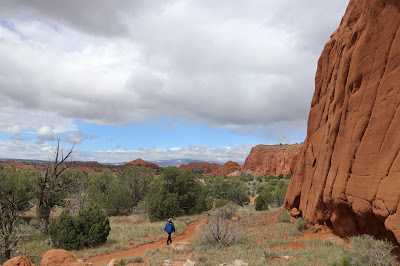It was a day of contrasts, from relatively warm weather when we walked in the Kodachrome Basic State Park through rain and finally heavy sleet as we negotiated Boulder Mountain. It was a route well worth taking as it took us through amazingly varied landscapes and majestic scenery - forgive the hyperbole but it really deserves it.
 |
| The red rocks are endlessly fascinating - to me, at least. |
 |
| Here's something unusual - dinosaur tracks in the rock going vertically up the rock face. A dinosaur only found in these parts apparently - Dontbelievicus Aworditicus. |
 |
| The rocks are very soft and get washed away quite easily. You can see the tracks of dripping mud quite clearly everywhere. it's like wax dripping from a candle. |
 |
| Up a blind alley? Actually, no. It's up a slot canyon - a narrow canyon off a bigger one. Got to get the terminology correct. |
 |
| This is called Face Rock. I don't see it myself. |
 |
| A little bit of retro nostalgia by the roadside in Canonville. I remember Mr Rogers in Bedwas having one like this in the mid 1950s. |
 |
| I said we passed through some magnificent scenery. Here's one example of many. |
 |
| And another a few miles on. All very distracting for the driver! |
 |
| This is countryside for those who like hiking. Lots of trails and lots of places to head for. If you want historic houses, gardens and museums, this isn't where you want to be. |
 |
| Snow on Boulder Mountain. Well, it was at nearly 10,000 feet. |
 |
| Low cloud over where we'll be trekking tomorrow. The weather forecast suggests that we should be putting our winter woolies on. |








No comments:
Post a Comment